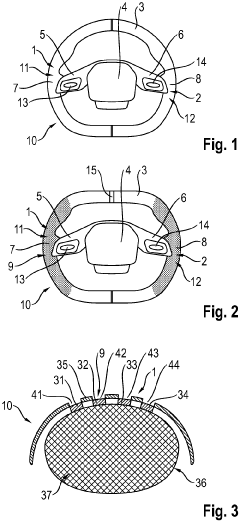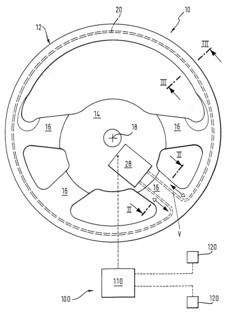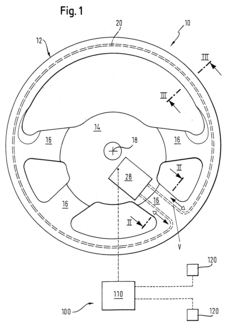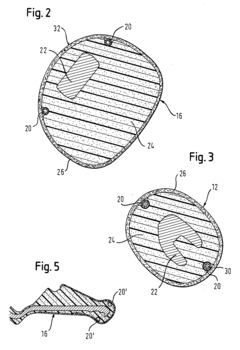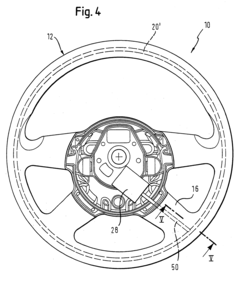How to Improve Steering Wheel Haptic Technologies?
JUL 18, 20259 MIN READ
Generate Your Research Report Instantly with AI Agent
Patsnap Eureka helps you evaluate technical feasibility & market potential.
Haptic Tech Evolution
Haptic technology in steering wheels has undergone significant evolution since its inception. Initially, haptic feedback in vehicles was limited to basic vibrations for alerts and warnings. The first generation of haptic steering wheels, introduced in the early 2000s, primarily focused on driver alertness and safety features, such as lane departure warnings and collision avoidance systems.
As automotive technology advanced, so did the sophistication of haptic feedback systems. The second generation, emerging in the mid-2010s, saw the integration of more nuanced haptic cues. These systems could provide directional feedback, mimicking the sensation of driving over rumble strips or road textures. This enhancement allowed for more intuitive communication of navigation instructions and potential hazards to drivers.
The current generation of haptic steering wheel technology, developed in the late 2010s and early 2020s, has expanded its capabilities significantly. Modern systems can simulate a wide range of tactile sensations, from subtle vibrations to more pronounced pulses. This advancement has enabled the implementation of complex haptic patterns that can convey a variety of information to the driver without requiring visual attention.
Recent developments have focused on improving the precision and responsiveness of haptic feedback. High-frequency actuators and advanced control algorithms now allow for more localized and targeted haptic sensations. This precision enables the steering wheel to communicate specific information about road conditions, vehicle dynamics, and even the status of various vehicle systems.
The integration of haptic feedback with other sensory inputs, such as audio and visual cues, has been a key area of innovation. This multi-modal approach enhances the driver's situational awareness and improves the overall driving experience. For example, haptic feedback can now work in conjunction with advanced driver assistance systems (ADAS) to provide a more comprehensive and intuitive interface between the driver and the vehicle.
Looking towards the future, the evolution of haptic steering wheel technology is likely to continue in several directions. One promising area is the development of adaptive haptic systems that can personalize feedback based on individual driver preferences and driving styles. Additionally, as vehicles become more autonomous, haptic feedback may evolve to facilitate smoother transitions between manual and automated driving modes.
The ongoing miniaturization of haptic components and improvements in energy efficiency are also driving innovation in this field. These advancements are enabling the integration of more sophisticated haptic systems into a wider range of vehicles, from entry-level models to luxury cars. As a result, the benefits of advanced haptic feedback are becoming accessible to a broader segment of drivers, potentially improving road safety and enhancing the driving experience for millions of people worldwide.
As automotive technology advanced, so did the sophistication of haptic feedback systems. The second generation, emerging in the mid-2010s, saw the integration of more nuanced haptic cues. These systems could provide directional feedback, mimicking the sensation of driving over rumble strips or road textures. This enhancement allowed for more intuitive communication of navigation instructions and potential hazards to drivers.
The current generation of haptic steering wheel technology, developed in the late 2010s and early 2020s, has expanded its capabilities significantly. Modern systems can simulate a wide range of tactile sensations, from subtle vibrations to more pronounced pulses. This advancement has enabled the implementation of complex haptic patterns that can convey a variety of information to the driver without requiring visual attention.
Recent developments have focused on improving the precision and responsiveness of haptic feedback. High-frequency actuators and advanced control algorithms now allow for more localized and targeted haptic sensations. This precision enables the steering wheel to communicate specific information about road conditions, vehicle dynamics, and even the status of various vehicle systems.
The integration of haptic feedback with other sensory inputs, such as audio and visual cues, has been a key area of innovation. This multi-modal approach enhances the driver's situational awareness and improves the overall driving experience. For example, haptic feedback can now work in conjunction with advanced driver assistance systems (ADAS) to provide a more comprehensive and intuitive interface between the driver and the vehicle.
Looking towards the future, the evolution of haptic steering wheel technology is likely to continue in several directions. One promising area is the development of adaptive haptic systems that can personalize feedback based on individual driver preferences and driving styles. Additionally, as vehicles become more autonomous, haptic feedback may evolve to facilitate smoother transitions between manual and automated driving modes.
The ongoing miniaturization of haptic components and improvements in energy efficiency are also driving innovation in this field. These advancements are enabling the integration of more sophisticated haptic systems into a wider range of vehicles, from entry-level models to luxury cars. As a result, the benefits of advanced haptic feedback are becoming accessible to a broader segment of drivers, potentially improving road safety and enhancing the driving experience for millions of people worldwide.
Market Demand Analysis
The market demand for improved steering wheel haptic technologies has been steadily increasing in recent years, driven by the growing emphasis on driver safety, comfort, and the overall driving experience. As vehicles become more technologically advanced, consumers are expecting more sophisticated and intuitive interfaces, including enhanced haptic feedback through the steering wheel.
One of the primary drivers of this demand is the automotive industry's focus on advanced driver assistance systems (ADAS) and semi-autonomous driving features. These technologies often rely on haptic feedback to communicate important information to the driver, such as lane departure warnings or collision alerts. The ability to convey these alerts through tactile sensations in the steering wheel has proven to be more effective and less distracting than visual or auditory cues alone.
Furthermore, the rise of electric and hybrid vehicles has created a new need for haptic feedback in steering wheels. These vehicles often lack the traditional engine vibrations that drivers are accustomed to, leading to a disconnected feeling while driving. Enhanced haptic technologies can help bridge this gap by providing subtle vibrations and sensations that mimic the feel of a traditional combustion engine, improving driver engagement and confidence.
The luxury automotive segment has been particularly receptive to advanced haptic technologies, with high-end manufacturers incorporating sophisticated feedback systems into their vehicles as a differentiating feature. This trend is expected to trickle down to mid-range and entry-level vehicles as the technology becomes more cost-effective and consumers become more aware of its benefits.
Market research indicates that the global automotive haptics market, which includes steering wheel technologies, is projected to grow significantly in the coming years. This growth is attributed to the increasing integration of haptic feedback in various vehicle controls and interfaces, with steering wheels being a key area of focus.
Consumer surveys have shown that drivers value haptic feedback for its ability to enhance safety and provide a more intuitive driving experience. Many respondents expressed interest in steering wheels that can communicate road conditions, navigation directions, and vehicle status through tactile sensations.
The aftermarket sector also presents opportunities for haptic technology improvements, as consumers seek to upgrade their existing vehicles with more advanced features. This has led to the development of retrofit solutions that can add haptic capabilities to older steering wheel models.
As the automotive industry continues to evolve towards more connected and autonomous vehicles, the demand for sophisticated haptic technologies in steering wheels is expected to grow further. Manufacturers and suppliers are investing in research and development to create more refined and versatile haptic systems that can adapt to various driving scenarios and user preferences.
One of the primary drivers of this demand is the automotive industry's focus on advanced driver assistance systems (ADAS) and semi-autonomous driving features. These technologies often rely on haptic feedback to communicate important information to the driver, such as lane departure warnings or collision alerts. The ability to convey these alerts through tactile sensations in the steering wheel has proven to be more effective and less distracting than visual or auditory cues alone.
Furthermore, the rise of electric and hybrid vehicles has created a new need for haptic feedback in steering wheels. These vehicles often lack the traditional engine vibrations that drivers are accustomed to, leading to a disconnected feeling while driving. Enhanced haptic technologies can help bridge this gap by providing subtle vibrations and sensations that mimic the feel of a traditional combustion engine, improving driver engagement and confidence.
The luxury automotive segment has been particularly receptive to advanced haptic technologies, with high-end manufacturers incorporating sophisticated feedback systems into their vehicles as a differentiating feature. This trend is expected to trickle down to mid-range and entry-level vehicles as the technology becomes more cost-effective and consumers become more aware of its benefits.
Market research indicates that the global automotive haptics market, which includes steering wheel technologies, is projected to grow significantly in the coming years. This growth is attributed to the increasing integration of haptic feedback in various vehicle controls and interfaces, with steering wheels being a key area of focus.
Consumer surveys have shown that drivers value haptic feedback for its ability to enhance safety and provide a more intuitive driving experience. Many respondents expressed interest in steering wheels that can communicate road conditions, navigation directions, and vehicle status through tactile sensations.
The aftermarket sector also presents opportunities for haptic technology improvements, as consumers seek to upgrade their existing vehicles with more advanced features. This has led to the development of retrofit solutions that can add haptic capabilities to older steering wheel models.
As the automotive industry continues to evolve towards more connected and autonomous vehicles, the demand for sophisticated haptic technologies in steering wheels is expected to grow further. Manufacturers and suppliers are investing in research and development to create more refined and versatile haptic systems that can adapt to various driving scenarios and user preferences.
Current Challenges
Steering wheel haptic technologies face several significant challenges in their current state of development and implementation. One of the primary obstacles is the limited range of haptic feedback that can be effectively conveyed through the steering wheel. The current technology struggles to provide a wide spectrum of tactile sensations that accurately represent various road conditions, vehicle dynamics, and driver alerts.
Another challenge lies in the integration of haptic systems with existing steering wheel designs. Many current haptic solutions require substantial modifications to the steering wheel structure, which can increase manufacturing costs and complexity. This integration challenge also extends to compatibility issues with different vehicle models and steering systems, making widespread adoption more difficult.
The power consumption of haptic systems presents another hurdle. As vehicles increasingly move towards electrification, every component's energy efficiency becomes crucial. Current haptic technologies often require significant power to operate effectively, which can impact the overall energy management of the vehicle, especially in electric and hybrid models.
Durability and reliability of haptic systems in the harsh automotive environment pose additional challenges. Steering wheels are subject to constant use, temperature fluctuations, and potential exposure to various elements. Ensuring that haptic systems can withstand these conditions while maintaining consistent performance over the vehicle's lifetime is a significant engineering challenge.
The issue of driver acceptance and adaptation is also a critical factor. Many drivers are accustomed to traditional steering feel and may find haptic feedback unfamiliar or distracting. Striking the right balance between providing useful information and avoiding sensory overload is a delicate task that requires extensive user testing and refinement.
Furthermore, there's the challenge of standardization across the automotive industry. With different manufacturers developing proprietary haptic systems, there's a lack of common standards for haptic feedback in steering wheels. This fragmentation can lead to inconsistent user experiences across different vehicle brands and models, potentially hindering widespread adoption and user acceptance.
Lastly, the cost-effectiveness of implementing advanced haptic technologies in steering wheels remains a significant barrier, especially for mass-market vehicles. The additional components and complexity introduced by these systems can substantially increase production costs, making it challenging to justify their inclusion in lower-priced vehicle segments.
Another challenge lies in the integration of haptic systems with existing steering wheel designs. Many current haptic solutions require substantial modifications to the steering wheel structure, which can increase manufacturing costs and complexity. This integration challenge also extends to compatibility issues with different vehicle models and steering systems, making widespread adoption more difficult.
The power consumption of haptic systems presents another hurdle. As vehicles increasingly move towards electrification, every component's energy efficiency becomes crucial. Current haptic technologies often require significant power to operate effectively, which can impact the overall energy management of the vehicle, especially in electric and hybrid models.
Durability and reliability of haptic systems in the harsh automotive environment pose additional challenges. Steering wheels are subject to constant use, temperature fluctuations, and potential exposure to various elements. Ensuring that haptic systems can withstand these conditions while maintaining consistent performance over the vehicle's lifetime is a significant engineering challenge.
The issue of driver acceptance and adaptation is also a critical factor. Many drivers are accustomed to traditional steering feel and may find haptic feedback unfamiliar or distracting. Striking the right balance between providing useful information and avoiding sensory overload is a delicate task that requires extensive user testing and refinement.
Furthermore, there's the challenge of standardization across the automotive industry. With different manufacturers developing proprietary haptic systems, there's a lack of common standards for haptic feedback in steering wheels. This fragmentation can lead to inconsistent user experiences across different vehicle brands and models, potentially hindering widespread adoption and user acceptance.
Lastly, the cost-effectiveness of implementing advanced haptic technologies in steering wheels remains a significant barrier, especially for mass-market vehicles. The additional components and complexity introduced by these systems can substantially increase production costs, making it challenging to justify their inclusion in lower-priced vehicle segments.
Existing Solutions
01 Haptic feedback mechanisms in steering wheels
Steering wheels are equipped with haptic feedback mechanisms to provide tactile information to drivers. These systems use various actuators to generate vibrations or other sensations, enhancing driver awareness and safety. The feedback can be used to alert drivers about road conditions, potential hazards, or to reinforce navigation instructions.- Haptic feedback mechanisms in steering wheels: Steering wheels are equipped with haptic feedback mechanisms to provide tactile information to drivers. These systems use various actuators to generate vibrations or other tactile sensations, enhancing the driver's awareness of vehicle conditions or potential hazards without relying solely on visual cues.
- Integration of haptic feedback with driver assistance systems: Haptic feedback in steering wheels is integrated with advanced driver assistance systems (ADAS) to convey important information. This integration allows for more intuitive communication of warnings, navigation instructions, or vehicle status updates through tactile sensations, improving driver safety and reducing cognitive load.
- Customizable haptic feedback patterns: Steering wheel haptic systems offer customizable feedback patterns to suit different driving scenarios or user preferences. These patterns can be programmed to convey specific types of information or adjusted for intensity, allowing for a personalized driving experience and improved information interpretation.
- Haptic feedback for autonomous and semi-autonomous vehicles: In autonomous and semi-autonomous vehicles, haptic feedback in steering wheels plays a crucial role in maintaining driver engagement and situational awareness. The system provides tactile cues to indicate transitions between autonomous and manual control, or to alert the driver of necessary interventions.
- Energy-efficient haptic feedback technologies: Advanced haptic feedback technologies for steering wheels focus on energy efficiency without compromising performance. These systems utilize innovative actuator designs and control algorithms to minimize power consumption while still delivering effective tactile sensations to the driver.
02 Integration of haptic feedback with vehicle systems
Haptic feedback in steering wheels is integrated with other vehicle systems such as navigation, driver assistance, and infotainment. This integration allows for more comprehensive and context-aware feedback, improving the overall driving experience and safety. The system can provide different types of haptic signals based on the information from various vehicle sensors and systems.Expand Specific Solutions03 Customizable haptic feedback patterns
Advanced haptic technologies in steering wheels allow for customizable feedback patterns. Drivers can adjust the intensity, frequency, and type of haptic feedback according to their preferences or specific driving conditions. This customization enhances user comfort and ensures that the feedback is effective for individual drivers.Expand Specific Solutions04 Haptic feedback for autonomous and semi-autonomous vehicles
Haptic feedback technologies are being developed for use in autonomous and semi-autonomous vehicles. These systems provide important tactile cues to drivers during the transition between autonomous and manual driving modes, helping to maintain situational awareness and improve safety during handovers.Expand Specific Solutions05 Energy-efficient haptic feedback systems
Research is focused on developing energy-efficient haptic feedback systems for steering wheels. These systems aim to provide effective tactile feedback while minimizing power consumption, which is particularly important for electric vehicles where energy efficiency is crucial. Advanced actuators and control algorithms are being employed to achieve this balance.Expand Specific Solutions
Key Industry Players
The steering wheel haptic technology market is in a growth phase, driven by increasing demand for advanced driver assistance systems and enhanced user experience in vehicles. The market size is expanding rapidly, with major automotive manufacturers and technology companies investing heavily in research and development. Companies like BMW, Audi, Tesla, and Volkswagen are at the forefront of implementing advanced haptic feedback systems in their vehicles. The technology is maturing quickly, with firms such as Bosch, Continental, and Harman International developing sophisticated solutions. However, there is still room for innovation and improvement in areas like precision, customization, and integration with other vehicle systems.
Volkswagen AG
Technical Solution: Volkswagen has introduced an advanced haptic steering wheel system as part of its Intelligent Drive concept. The technology incorporates multiple haptic feedback mechanisms, including vibration motors and variable stiffness actuators. Volkswagen's system is designed to provide a range of tactile sensations, from subtle alerts to more pronounced steering interventions. The haptic feedback is integrated with the vehicle's sensor suite and can communicate various types of information, such as navigation directions, safety warnings, and even fuel efficiency recommendations. Volkswagen has also implemented a feature called "Haptic Lane Guidance," which uses gentle steering torque to help drivers maintain their lane position [7][8]. The system is designed to be highly customizable, allowing drivers to adjust the intensity and types of haptic feedback according to their preferences.
Strengths: Versatile haptic feedback options, integration with multiple vehicle systems, customizable user experience. Weaknesses: May require extensive software updates to fully utilize all features, potential for information overload if not properly calibrated.
Continental Teves AG & Co. oHG
Technical Solution: Continental has introduced an innovative haptic feedback system for steering wheels called "Active Haptic Feedback." This technology uses electromechanical actuators embedded in the steering wheel rim to generate precise tactile signals. The system can produce various haptic patterns, including vibrations, pulses, and continuous feedback. Continental's solution is designed to work in conjunction with advanced driver assistance systems and autonomous driving features. It can provide warnings for lane departure, forward collision alerts, and even guidance for semi-autonomous driving modes. The haptic feedback is customizable and can be adjusted based on the severity of the situation or driver preferences [2][5]. Additionally, Continental's system incorporates pressure sensors to detect the driver's grip on the wheel, allowing for more contextual and responsive haptic feedback.
Strengths: High precision haptic feedback, integration with autonomous driving features, grip detection for contextual responses. Weaknesses: May require specialized training for drivers to interpret different haptic signals effectively.
Core Haptic Innovations
Steering wheel, method for operating a motor vehicle, haptically perceptible structure, cover material and molded body
PatentActiveDE102019133651A1
Innovation
- A steering wheel with a haptically perceptible structure that can change between states, featuring elevations that are barely perceptible in normal driving and significantly more perceptible in sporty modes, controlled electrically to enhance driver feedback.
Vehicle steering wheel and safety system
PatentInactiveUS20040025624A1
Innovation
- A vehicle steering wheel with a fluid-filled tube and a device generating pressure waves to create haptic signals, allowing for varying intensity and form of vibrations or oscillations, which can be perceived by the driver without mechanical parts, ensuring the signal is conveyed effectively through the steering wheel rim, even with a leather covering.
Safety Regulations
Safety regulations play a crucial role in the development and implementation of steering wheel haptic technologies. As these technologies become more sophisticated and widespread, regulatory bodies are increasingly focused on ensuring their safe integration into vehicles.
The National Highway Traffic Safety Administration (NHTSA) in the United States has established guidelines for in-vehicle electronic devices, which include haptic feedback systems. These guidelines aim to minimize driver distraction and maintain vehicle control. Manufacturers must demonstrate that their haptic technologies do not interfere with the primary task of driving and can be safely operated while the vehicle is in motion.
In the European Union, the United Nations Economic Commission for Europe (UNECE) has developed regulations specifically addressing advanced driver assistance systems (ADAS), which often incorporate haptic feedback. These regulations require thorough testing and validation of haptic systems to ensure they enhance driver awareness without causing confusion or overreliance on automated features.
The International Organization for Standardization (ISO) has also contributed to the regulatory landscape with ISO 26262, which addresses functional safety in road vehicles. This standard requires manufacturers to conduct comprehensive risk assessments and implement appropriate safety measures for all electronic systems, including haptic technologies in steering wheels.
Regulatory bodies are particularly concerned with the potential for haptic feedback to startle or distract drivers. As a result, manufacturers must carefully calibrate the intensity and frequency of haptic signals to provide clear information without causing undue alarm. Additionally, there is a growing emphasis on ensuring that haptic feedback systems are fail-safe, with redundancies in place to prevent malfunctions that could compromise vehicle safety.
The integration of haptic technologies with other advanced driver assistance systems has led to new regulatory challenges. For instance, the interplay between haptic warnings and visual or auditory alerts must be carefully coordinated to avoid overwhelming the driver with sensory input. Regulators are increasingly requiring manufacturers to demonstrate the harmonious operation of these multi-modal feedback systems.
As autonomous driving technologies advance, regulators are also considering how haptic feedback in steering wheels can facilitate the safe transition between automated and manual driving modes. This has led to discussions about standardizing haptic cues across different vehicle manufacturers to ensure consistency and reduce the potential for driver confusion.
Looking ahead, regulatory bodies are likely to continue refining their approach to steering wheel haptic technologies. This may include the development of more specific performance standards, testing protocols, and certification processes. Manufacturers will need to stay abreast of these evolving regulations to ensure their haptic systems not only enhance driver experience but also meet stringent safety requirements.
The National Highway Traffic Safety Administration (NHTSA) in the United States has established guidelines for in-vehicle electronic devices, which include haptic feedback systems. These guidelines aim to minimize driver distraction and maintain vehicle control. Manufacturers must demonstrate that their haptic technologies do not interfere with the primary task of driving and can be safely operated while the vehicle is in motion.
In the European Union, the United Nations Economic Commission for Europe (UNECE) has developed regulations specifically addressing advanced driver assistance systems (ADAS), which often incorporate haptic feedback. These regulations require thorough testing and validation of haptic systems to ensure they enhance driver awareness without causing confusion or overreliance on automated features.
The International Organization for Standardization (ISO) has also contributed to the regulatory landscape with ISO 26262, which addresses functional safety in road vehicles. This standard requires manufacturers to conduct comprehensive risk assessments and implement appropriate safety measures for all electronic systems, including haptic technologies in steering wheels.
Regulatory bodies are particularly concerned with the potential for haptic feedback to startle or distract drivers. As a result, manufacturers must carefully calibrate the intensity and frequency of haptic signals to provide clear information without causing undue alarm. Additionally, there is a growing emphasis on ensuring that haptic feedback systems are fail-safe, with redundancies in place to prevent malfunctions that could compromise vehicle safety.
The integration of haptic technologies with other advanced driver assistance systems has led to new regulatory challenges. For instance, the interplay between haptic warnings and visual or auditory alerts must be carefully coordinated to avoid overwhelming the driver with sensory input. Regulators are increasingly requiring manufacturers to demonstrate the harmonious operation of these multi-modal feedback systems.
As autonomous driving technologies advance, regulators are also considering how haptic feedback in steering wheels can facilitate the safe transition between automated and manual driving modes. This has led to discussions about standardizing haptic cues across different vehicle manufacturers to ensure consistency and reduce the potential for driver confusion.
Looking ahead, regulatory bodies are likely to continue refining their approach to steering wheel haptic technologies. This may include the development of more specific performance standards, testing protocols, and certification processes. Manufacturers will need to stay abreast of these evolving regulations to ensure their haptic systems not only enhance driver experience but also meet stringent safety requirements.
User Experience Impact
The integration of haptic technologies in steering wheels has significantly transformed the driving experience, enhancing both safety and comfort. These advancements have a profound impact on user experience, creating a more intuitive and responsive interface between the driver and the vehicle.
One of the primary benefits of steering wheel haptic technologies is the improvement in driver awareness. By providing tactile feedback through the steering wheel, drivers can receive important information without taking their eyes off the road. This enhanced situational awareness contributes to safer driving conditions, as drivers can quickly respond to potential hazards or changes in road conditions.
The user experience is further enriched by the customization options offered by haptic technologies. Drivers can often adjust the intensity and type of feedback to suit their preferences, creating a more personalized driving experience. This level of customization allows for better adaptation to different driving styles and conditions, enhancing overall comfort and control.
Haptic feedback also plays a crucial role in reducing driver fatigue during long journeys. The subtle vibrations and tactile cues can help maintain driver alertness and engagement, potentially mitigating the risks associated with drowsy driving. This aspect of the technology directly contributes to improved safety and a more enjoyable driving experience over extended periods.
Moreover, the integration of haptic technologies with advanced driver assistance systems (ADAS) has opened up new possibilities for user interaction. Steering wheel haptics can now communicate complex information about lane departure warnings, collision avoidance, and adaptive cruise control, providing drivers with a more intuitive understanding of the vehicle's autonomous functions.
The emotional connection between driver and vehicle is another area where haptic technologies have made significant strides. The tactile feedback creates a more immersive driving experience, enhancing the sense of control and connection with the vehicle. This emotional engagement can lead to increased driver satisfaction and brand loyalty.
As these technologies continue to evolve, we can expect to see even more sophisticated applications that further enhance the user experience. Future developments may include more nuanced feedback systems that can convey a wider range of information, potentially integrating with other sensory inputs to create a truly holistic driving experience.
One of the primary benefits of steering wheel haptic technologies is the improvement in driver awareness. By providing tactile feedback through the steering wheel, drivers can receive important information without taking their eyes off the road. This enhanced situational awareness contributes to safer driving conditions, as drivers can quickly respond to potential hazards or changes in road conditions.
The user experience is further enriched by the customization options offered by haptic technologies. Drivers can often adjust the intensity and type of feedback to suit their preferences, creating a more personalized driving experience. This level of customization allows for better adaptation to different driving styles and conditions, enhancing overall comfort and control.
Haptic feedback also plays a crucial role in reducing driver fatigue during long journeys. The subtle vibrations and tactile cues can help maintain driver alertness and engagement, potentially mitigating the risks associated with drowsy driving. This aspect of the technology directly contributes to improved safety and a more enjoyable driving experience over extended periods.
Moreover, the integration of haptic technologies with advanced driver assistance systems (ADAS) has opened up new possibilities for user interaction. Steering wheel haptics can now communicate complex information about lane departure warnings, collision avoidance, and adaptive cruise control, providing drivers with a more intuitive understanding of the vehicle's autonomous functions.
The emotional connection between driver and vehicle is another area where haptic technologies have made significant strides. The tactile feedback creates a more immersive driving experience, enhancing the sense of control and connection with the vehicle. This emotional engagement can lead to increased driver satisfaction and brand loyalty.
As these technologies continue to evolve, we can expect to see even more sophisticated applications that further enhance the user experience. Future developments may include more nuanced feedback systems that can convey a wider range of information, potentially integrating with other sensory inputs to create a truly holistic driving experience.
Unlock deeper insights with Patsnap Eureka Quick Research — get a full tech report to explore trends and direct your research. Try now!
Generate Your Research Report Instantly with AI Agent
Supercharge your innovation with Patsnap Eureka AI Agent Platform!
